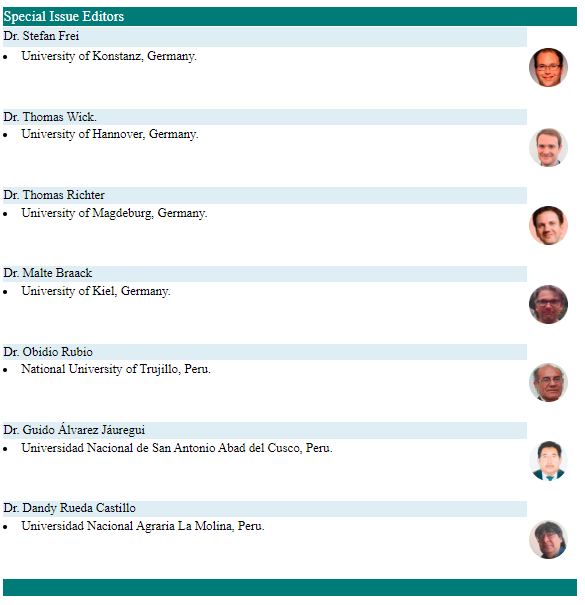MESOSCALE WEATHER SIMULATIONS OF NORTHERN PERU (2015) USING BRAZILIAN REGIONAL ATMOSPHERIC MODELING SYSTEM (BRAMS)
DOI:
https://doi.org/10.17268/sel.mat.2015.02.01Keywords:
Numerical Simulations, BRAMS, Weather, El Niño phenomenon, atmospheric modelingAbstract
The warm of the tropical pacific ocean generate the El Niño phenomenon. The Peru between the years 1997 and 1998 took big materials losses and human victims because the presence of EL NIÑO.Now the scientists try to make a prediction of the magnitude of natural phenomenon using different methods of simulation. Our objective are study the changes in the weather variables such that:
temperature, wind fields and relative humidity, from October to November in 2015 and compared with years 1997 and 1998. We used the BRAMS (Brazilian Regional Atmospheric Modelling System
) model; with this model We could analyze the differences of temporal and spatial changes for the weather variables. The variation of temperature in northern Peru was around 18 and 29 degrees
Celsius , relative humidity was around 35 and 100% of the coast, the wind fields were 2.7 km/h to 9.9 km/h . The Temperature at regions of interest: Tumbes, Piura, Lambayeque and La Libertad
presented a decrease in 9, 5,6 and 6 degrees celsius from octuber to November, respectively. In conclusion, the weather variables have presented a decrease in November 2015, these behavior did
not occur in the years 1997 and 1998.
References
Chang, Y-T. and Du, L. and Zhang, S-W. and Huang, P-F, Sea level variations in the tropical Pacific Ocean during two types of recent El Niño events, Global and Planetary change, V108, 119-127,2013.
Chen, D. and Cane, M.A, El Niño prediction and
predictability, Computational physic, volume =227, (2008), 3625-3640.
Dewitte, B. and Vazquez-Cuervo, J. and Goubanova, K. and Illig, S. and Takahashi, K. and Cambon, G. and Purca, S. and Correa, D. and Gutierrez, D. and Sifeddine, A. and Ortlieb, L., Change in El Niño flavours over 1958-2008: Implications for the long-term trend of the upwelling off Peru, Deep-Sea Research II, 77, (2012), 143-156.
Garcia, A. M. and Vieira, J. P. and Winemiller, K. O., Effects of 1997-1998 El Niño on the dyamics of the shallow-water fish assenblage of the Patos Lagoon Estuary (Brazil), Estuarine, Coastal and Shelf Science, 57, 489-500, (2003).
Colas, F. and Capet, X. and McWilliams J. C. and Shchepetkin, A., 1997-1998 El Niño off Peru: A
numerical Study, Progress in Oceanography, 79, (2008), 138-155.
Guinez, M. and Valdés, J. and Sifeddine, A. and Boussafir, M. and Dávila, P. M., Anchovy population and ocean-climatic fluctuations in the Humboldt Current System during the last 700 years and their implications, Palaeogeography, Palaeoclimatology, Palaeoecology, 415, (2014), 210-224.
Avissar, R. and Pielke, R. A., The impact of plant stomatal control on mesoscale atmospheric circulations, Agricultural and Forest Metereology, 54, (1991), 353-372.
Davey, Ch. A. and Pielke, R. A. and Gallo, K. P., Differences between near-surface equivalent temperature and temperature trends for the Eastern United States Equivalent temperature as an alternative measure of heat content, Global and Planetary Change, 54, (2006), 19-32.
, Garcia, S. Y. and Salio, P. and Nicolini, M., Verificación de los pronosticos del modelo BRAMS centrado en la región subtropical de sudamerica, Rev. Brasile~na de Metereologia, 27(3), (2012), 291-306.
Oliveira de Souza, D. and dos Santos A. R. and Guedes, M. N, Urbanization effects on the microclimate of Manaus: A modeling study, Atmospheric Research, 167, (2016), 237-248
Published
How to Cite
Issue
Section
License
The authors who publish in this journal accept the following conditions:
1. The authors retain the copyright and assign to the journal the right of the first publication, with the work registered with the Creative Commons Attribution License,Atribución 4.0 Internacional (CC BY 4.0) which allows third parties to use what is published whenever they mention the authorship of the work And to the first publication in this magazine.
2. Authors may make other independent and additional contractual arrangements for non-exclusive distribution of the version of the article published in this journal (eg, include it in an institutional repository or publish it in a book) provided they clearly state that The paper was first published in this journal.
3. Authors are encouraged to publish their work on the Internet (for example, on institutional or personal pages) before and during the review and publication process, as it can lead to productive exchanges and to a greater and more rapid dissemination Of the published work.












